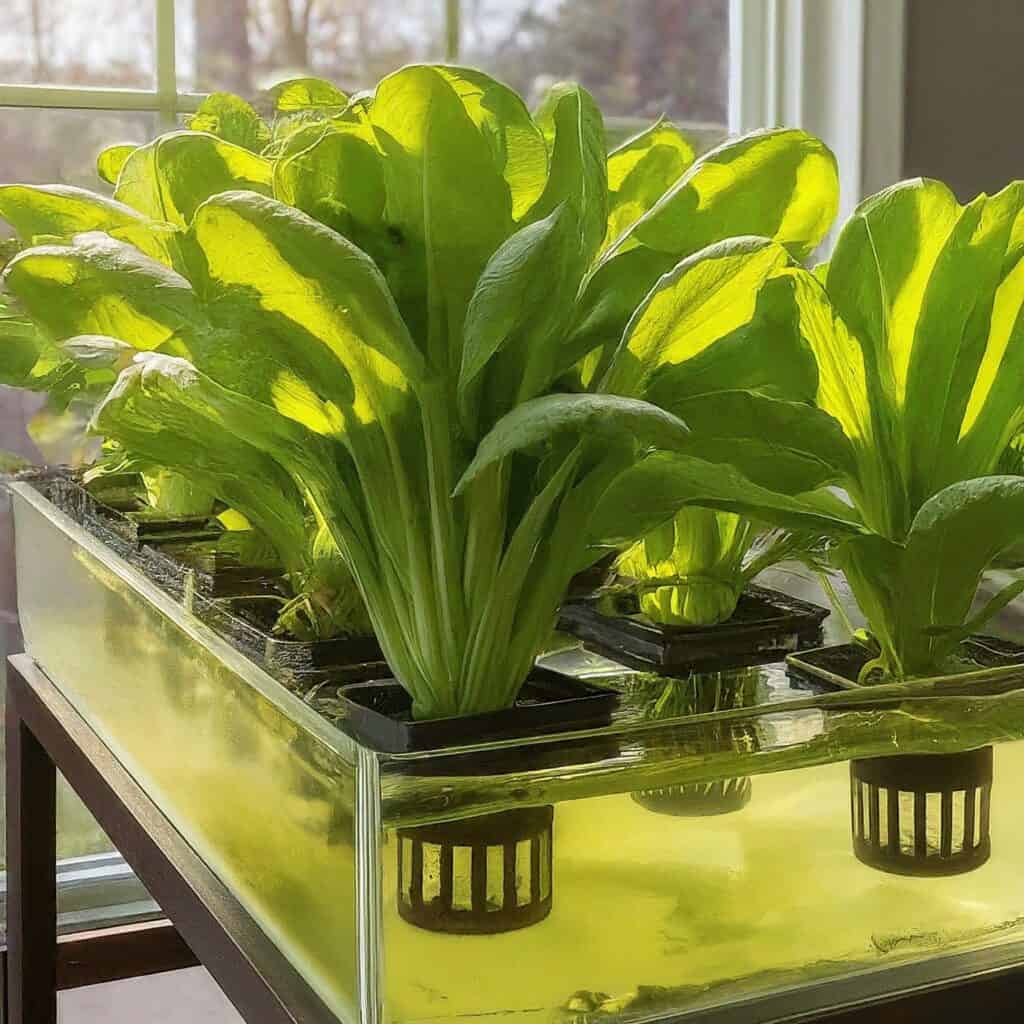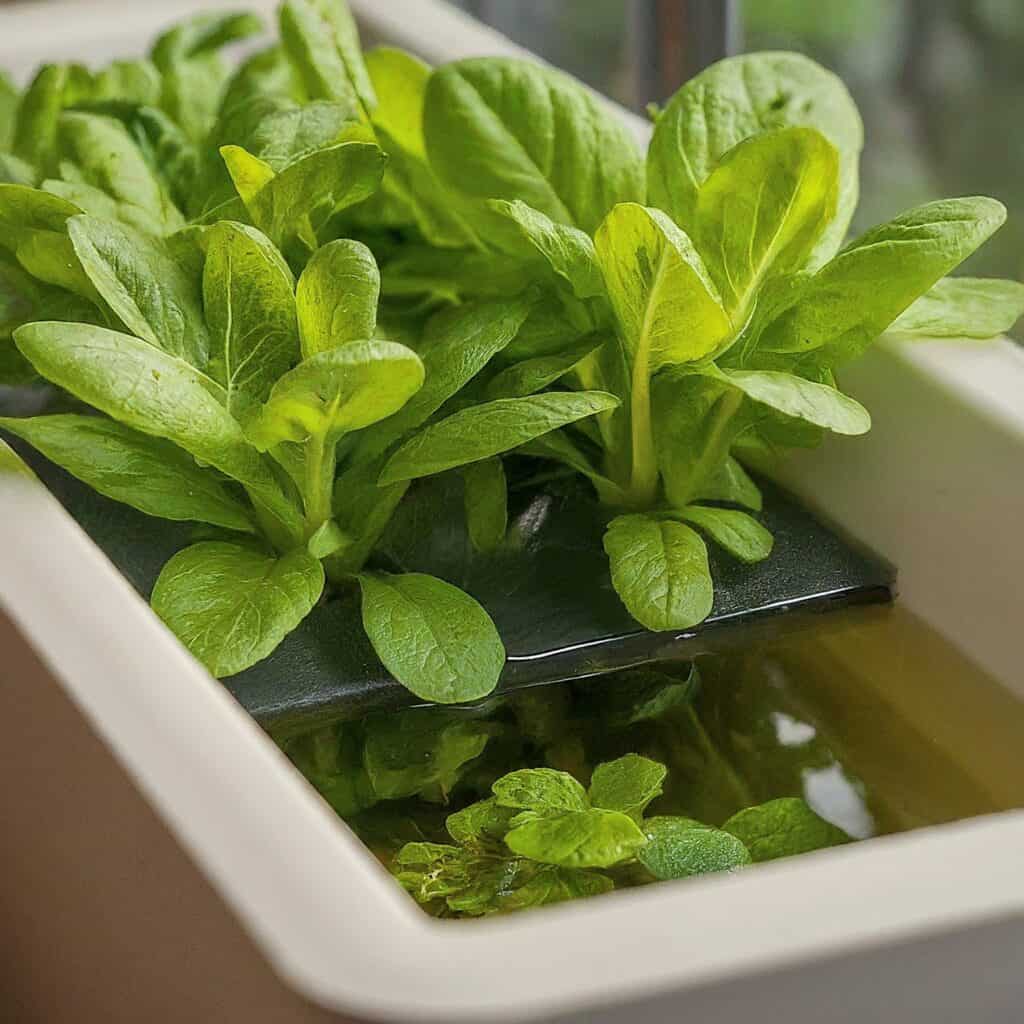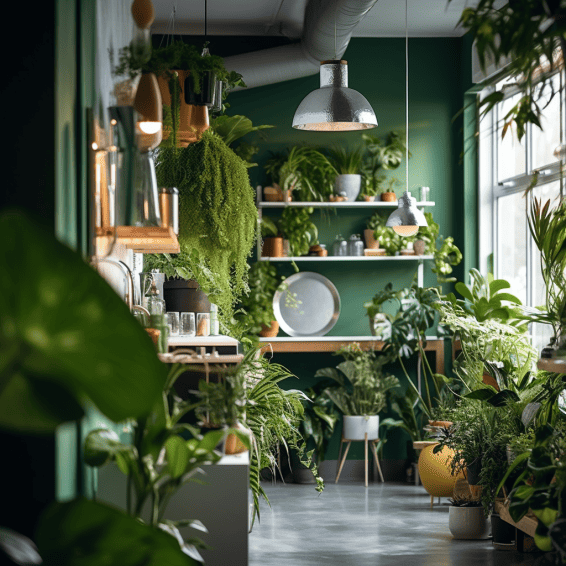Tired of brown thumbs and wilting plants? Hydroponics is the way to go! Grow lush indoor gardens without soil – it’s easier than you think.
KEY TAKEAWAY
- Hydroponics is a soil-free way to grow lush indoor gardens using nutrient-rich water solutions.
- Hydroponics offers benefits like increased yields, reduced water usage, and better pest control compared to traditional gardening.
- Getting started with hydroponics is easier than you think – you can build a simple system using everyday materials like storage containers and air pumps.
Growing plants without soil may sound unusual, but as I learned from the Epic Gardening website, hydroponics is a clever way to cultivate crops with only water and nutrients. Using this method, you can yield bigger harvests in less space and use less H2O too.
Best of all for newbies, systems like deep water culture are really relaxing—all you need is a bucket! You’ll keep plants happy by simply adding nutrients to the liquid. Seems like hydro could make gardening a breeze.
Want to learn more tricks? Keep reading!
Hydroponics for Beginners – Getting Started
Growing plants without soil is becoming really popular lately. Known as hydroponics, this method uses nutrient-rich water solutions instead of regular dirt. Let me tell you why hydroponics offers benefits worth thinking about.
To start, hydroponics gives you way more control over how plants grow. By adjusting things like temperature, pH levels, lighting, and nutrients, you can make the best system for fast big harvests.
This customization tailored for each crop usually means larger yields and veggies with higher nutrition versus ones from dirt. I was surprised at how huge and healthy my cherry tomatoes got with basic hydroponics vs in my garden.
Also great, hydroponics uses less water and fertilizer than traditional gardening since nothing leaks out and the nutrient-water recycles forever. This lets you grow all year long anywhere, even apartments or small spaces outside.
Fewer pests and diseases happen too because a lack of dirt means fewer places for critters and microbes to hang out. I can grow nutrition-packed lettuce on my balcony all seasons instead of depending on moody weather or what’s at the store.
Some say hydroponics takes more learning than dirt gardening. (1)
But simple cheap systems brought me and other newbies in. Here are a few that work for starters to try out and get your feet wet with this rewarding method.
Simple Hydroponic Systems for Beginners

For folks short on space, the bubbly method works great. In this setup, plants like lettuce sit in pots filled with clay pebbles or coconut fiber above a water tank. An air pump hooked to a bubbler gently stirs the water below, keeping the roots nice and damp while the top stays airy. I fit this in small areas like windowsills and tables, yielding tons of herbs in tiny spaces.
Deep water culture (DWC) is one of the lowest maintenance hydroponic designs out there. Here, plant roots hang freely in nutrient-rich water, needing just occasional checks of pH and water levels. I made my own using an old plastic bin and it grew lettuce with barely any effort from me thanks to how sturdy this technique is.
Wicking beds also provide an easy way to do hydroponics outside. Build a sloped box lined with a waterproof layer and wicking rope to draw solution up, watering vegetables and herbs planted above.
I had amazing basil and strawberries like this, enjoying the best of indoor and outdoor growing. It works well since the rope pulls just what the plants can handle to the surface for their roots. Giving hydroponics a try has never been simpler!
Essential Nutrients For Plant Growth
The main things plants need to grow big and bountiful are nitrogen, oxygen, hydrogen, and carbon.(2)
Together these make up over 90% of what’s inside plants. Nitrogen acts as the basic building block for proteins in leaves, stems, and much more.
Oxygen and hydrogen combine to make water, which drives photosynthesis and how plants digest food. And carbon lays the foundation for plants while also being their sole energy source for soaking up sunshine. Remembering this from high school science class helped ensure my hydroponic crops grew to their full potential under my care.
In case you need a refresher:
- Nitrogen builds proteins throughout plants and makes them green.
- Oxygen and hydrogen team up to create H2O, transporting nutrients inside plants and allowing photosynthesis to do its work.
- Carbon provides the basic structure for leaves, flowers, and fruits while also powering photosynthesis so sugars can produce.
Memorizing the roles of just these four key nutrients took away a lot of the mystery for me. I could see the difference the right ratios made compared to starting out guessing. Whether aquaponics or DWC, let these nutritional heroes nourish your gardens to bounty!
Building Your Own Hydroponic Setup

Putting together the basics of a hydroponic garden takes very little money. You can use things like plastic tubs, buckets, old fish tanks or even bathtubs as reservoirs – choose what works best for your space.
Net pots, tubing, and air pumps from yard sales or local “buy nothing” groups save cash too. Countless online tutorials, like the simple deep water culture guide I followed from Square Mile Farms, make the process easy by showing diagrams and lists of parts.
Setting it up is a breeze when you break it down:
- Find a water-tight container like a storage bin for your solution reservoir.
- Track down pots, pipes, and a pump to get oxygen flowing to roots.
- Have pebbles, clay balls or mesh nets ready for plant roots.
- Blend up some basic organic nutrient concentrate.
- Add water, adjust pH, and your system is booted up!
With just a bit of scavenging and a to-do list from the web, anyone can get veggies flowing indoors or out. The fish tank I converted held weeks of lettuce with ease. Best of all, modifying designs keeps harvests coming with practically zero soil and minimal fuss.
Choosing Plants For Hydroponics
Some crops do better than others based on their roots. Leafy greens, herbs, and smaller foods needing regular water generally work well in different hydro setups. Cherry tomatoes, cucumbers, and strawberries also grew awesome for me since their shallow roots stay damp.
Kale needs less topping off by comparison. Avoid big rooty plants that can go awhile between drinks unless your system waters automatically like ebb and flow or drip. Starting from seed is no problem so long as the mature plant has room. Experimenting shows what rocks for you!
It’s smart to pick:
- Salad greens, herbs – Thrive with consistent moisture.
- Tomatoes, berries, melons – Shallow roots stay happy.
- Avoid huge root balls unless your setup waters on schedule.
- Kale and such need less regular H2O top-ups.
- Seeds accommodate any variety with space to full size.
Find your hydroponic groove by trying different varieties. My cherry tomatoes, basil and strawberries boomed while larger plants did okay too with drip watering. Now you’re ready to fill tubs with the right farmer’s market stars!
Tips For Successful Hydroponic Gardening
A few things helped my hydroponic ventures go smooth: Keeping nutrient solution levels stable with occasional tests and top-ups ensures roots stay happy and strong. Proper airflow transfers oxygen down below too, so check on tubing, filters, pumps.
Around 12-16 hours per day of bright indirect light from grow lights delivers just what plants need inside. Cleaning equipment between crops minimizes potential pest transfer that’s impossible in soil gardens.
More tips:
- Maintain balanced nutrients for giant healthy harvests.
- Inspect airflow so oxygen reaches the entire roots.
- Use 12-16 hours of grow lights indoors for photosynthesis.
- Sanitize between batches to avoid hitchhikers.
- Matching crops and systems grows experience over time.
The best teacher? Trial and error! Start simple, observe closely, and successes will follow. With hydroponics, no excuses stand in the way of fresh homegrown meals. Master these tricks, and you’ll smoothly reap abundant crops on your terms. Before long, you’ll be the hydro expert sharing tips with other new gardeners.
FAQ
What is a net pot and how does it help with hydroponics?
Net pots are containers with a mesh or perforated bottom that allow the plant’s roots to grow down into the water or growing medium. They help support the plant and allow for better aeration and nutrient absorption in a hydroponic system.
How do I test and adjust the pH level in my hydroponic system?
Using a pH meter or testing kit, you can regularly check the pH of your water solution and make adjustments as needed. Maintaining the proper pH, usually between 5.5-6.5, is crucial for healthy plant growth in a hydroponic setup.
What is root rot and how can I prevent it in my hydroponic garden?
Root rot is a common issue caused by overwatering, poor aeration, or bacterial/fungal infections. To prevent it, ensure your system has adequate drainage, air stones for oxygenation, and use a clean, sterile growing medium. Monitor water levels and replace solution regularly.
Can I use PVC pipe to build a hydroponic system?
Yes, PVC pipe can be a cost-effective material for constructing a basic hydroponic system. The pipes can be used to create channels or troughs to hold the plants and nutrient solution. Just be sure to use food-grade PVC and properly seal any connections.
What type of air stone do I need for a DWC (deep water culture) hydroponic system?
An air stone is essential in a DWC system to keep the roots oxygenated. Look for a medium to large-sized air stone that can provide ample air flow and bubbles throughout the water reservoir.
Can I grow plants hydroponically year-round, even in colder climates?
Absolutely! One of the benefits of hydroponics is the ability to grow plants indoors, protected from outdoor weather conditions. With the right grow lights and temperature control, you can maintain an ideal growing environment for a successful year-round hydroponic garden.
What is a wick system and how does it work for hydroponics?
A wick system is a simple hydroponic method that uses a wick, like a piece of cotton rope, to draw nutrient solution up from a reservoir into the growing medium. This passive system is low-maintenance and great for beginners.
Can I use coconut coir as a growing medium in my hydroponic setup?
Yes, coconut coir is a popular and effective growing medium for hydroponics. It provides excellent water and air retention, making it well-suited for hydroponic systems. Just be sure to properly prepare and pH balance the coir before use.
How can I use a grow light to supplement natural light for indoor hydroponics?
Grow lights, like LED or fluorescent bulbs, can provide the necessary spectrum of light for healthy plant growth when natural sunlight is limited. Position the lights close to your plants and adjust the duration to mimic an ideal growing season.
What is a nutrient film technique (NFT) system and how does it work?
In an NFT system, a shallow stream or “film” of nutrient-rich water continuously flows over the plant roots, providing them with a constant supply of water and nutrients. This technique allows for efficient use of space and resources.
Can I start seeds directly in a hydroponic growing tray?
Yes, you can start seeds in a hydroponic growing tray or net pots filled with a sterile growing medium like rockwool or coconut coir. Just be sure to keep the medium moist and provide the right lighting conditions for germination.
What are some common issues I may face when growing plants hydroponically?
Some common challenges include maintaining proper pH and nutrient levels, preventing root rot, managing algae growth, and ensuring adequate air circulation. Regularly monitoring your system and making adjustments as needed can help overcome these issues.
Wrapping Things Up
In wrapping up, hydroponics opens up lots of new ways to grow plants without dirt. After trying different methods for years, I’m confident the wins outweigh any losses. For folks looking for sustainable local food or a fun new hobby, what are you waiting for?!
Dive in with an easy system now and start enjoying all the plentiful, engaging rewards this innovative technique brings. Discovering new ways plants thrive without soil has been one of the most interesting journeys I’ve taken. I’m excited for others to have that experience too through hydroponics.
References
- https://en.wikipedia.org/wiki/Hydroponics
- https://www.advancednutrients.com/articles/easy-hydroponics-beginners-guide/
Related Articles
- https://tophydroponicgarden.com/wick-system/
- https://tophydroponicgarden.com/hydroponics-introduction/
- https://tophydroponicgarden.com/hydroponic-systems/
Was this helpful?

I’m Barrie L., a passionate hydroponic gardening enthusiast dedicated to cultivating thriving, soil-less gardens. With a focus on all things hydroponic, I share my expertise on innovative growing techniques and sustainable practices through my blog, tophydroponicgarden.com. As a seasoned hydroponics specialist, my goal is to inspire and guide fellow gardeners in harnessing the power of water-based cultivation for bountiful and eco-friendly harvests. I’m also an author of the book “Hydroponics For Absolute Beginners: Your Step By Step Guide For How To Create An Hydroponics System At Home Without Soil, For Growing Vegetable, Fruit And Herbs.” which is sold on Amazon. Join me on a journey of redefining the way we cultivate plants, one nutrient-rich solution at a time. Happy growing!


